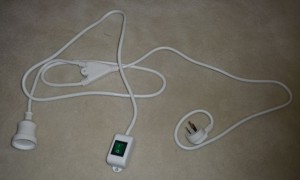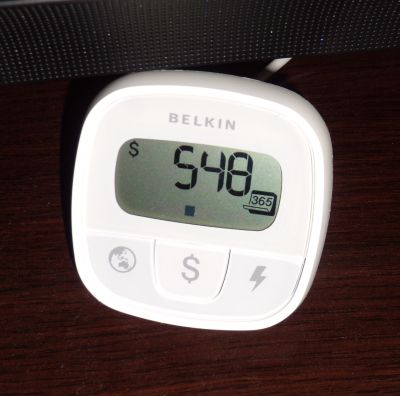As I mentioned in this entry about the Belkin Power Usage Meter I bought I’ve been monitoring the amount of power being used by the devices in this house when they are in standby mode. Eliminating the power used is simple, just turn the power off at the wall when it’s not getting used. Trouble is that the power points are hard to reach, and in one case here, impossible to reach without having double jointed shoulders.
The answer is some sort of remote switching. I’ve seen some power boards that sense the current draw by one device (say your TV) and when these drops below a certain limit they power down (via relays I imagine) the other devices on the power board. Trouble with this is that the master device is still in standby mode. The other idea I had was to put an inline switch into an extension cord and stick the extension cord somewhere that could easily be reached. Trouble with this is that it would be ugly and one of my friends would have to come and do the actual work for me because playing with 240V makes me nervous.
While reading the Whirlpool Forums last week I came across a mention of a product called the EcoSwitch. Basically it’s an extension cord with a T junction with an illuminated rocker switch at the end the leg of the T. You plug one end of the EcoSwitch into the power, the other into whatever powerboard/devices you want to control and stick the switch somewhere easily accessible. The rocker switch is illuminated when the power is on, and dark when not. Just turn off the switch at night when you’re finished with TV, Computer, or whatever. You can see a picture of one of the EcoSwitches above with the rocker switch visible at centre bottom of the image.
The EcoSwitches cost about $20 plus shipping so I ponied up for 4 (3 I needed and one spare) of them direct from the supplier. They arrived 5 days later. The EcoSwitches work exactly as advertised and even come with double sided tape to stick the switch end down somewhere that is easily reached. However, the tape is useless and in all three spots that I am using them the switch kept coming unstuck and dropping back behind whatever I was trying to switch off. Very annoying. However, it was easily fixed by using some proper 3M double sided tape we had laying around.
My three EcoSwitches are plugged into two TV/Media centers that were drawing 40W in standby mode for 20 hours day and into a PC/Laptop setup that was drawing 10W in standby mode for 8 hours a day. The EcoSwitches will prevent 321kWh of standby power being wasted annually which is about $80.25 saved on our power bill each year. Not a bad return on investment for $60 worth of EcoSwitches.


